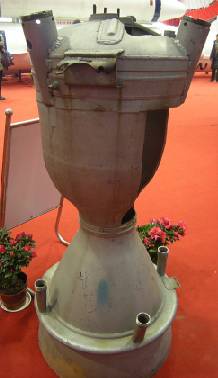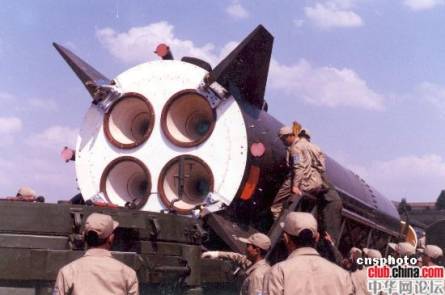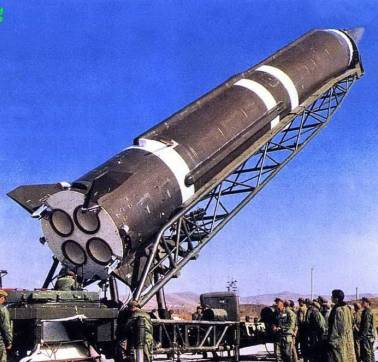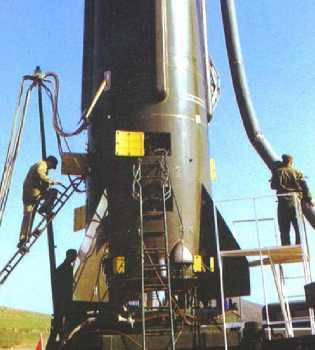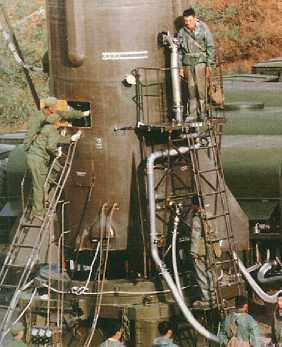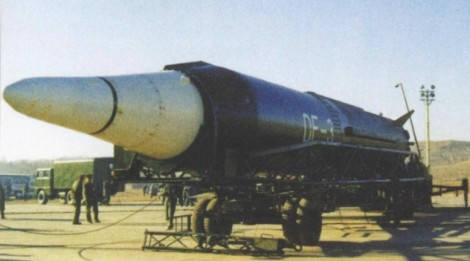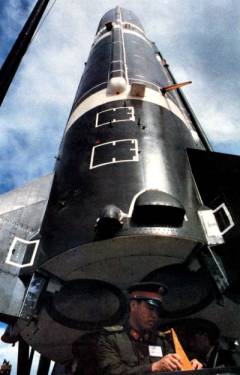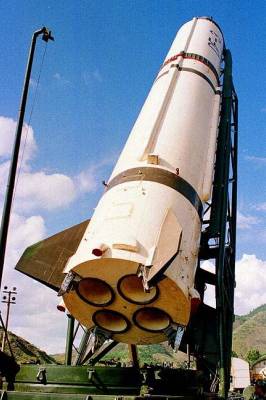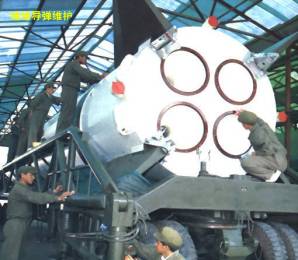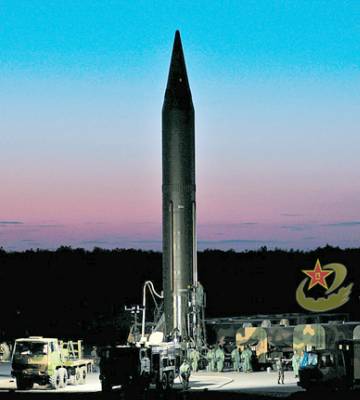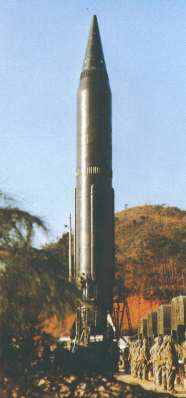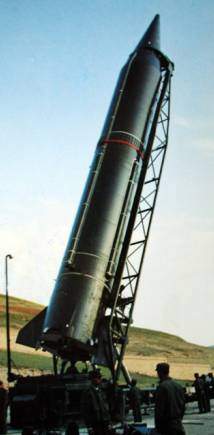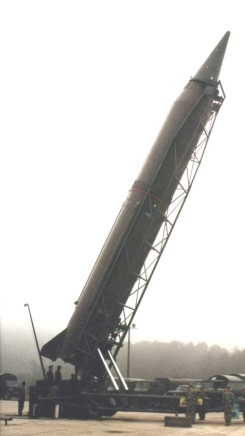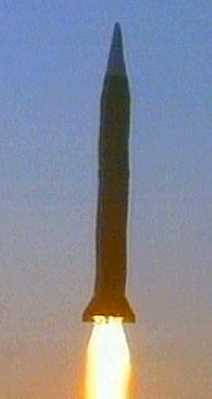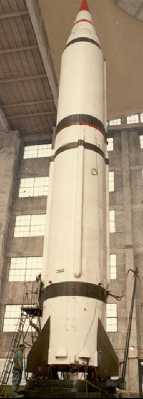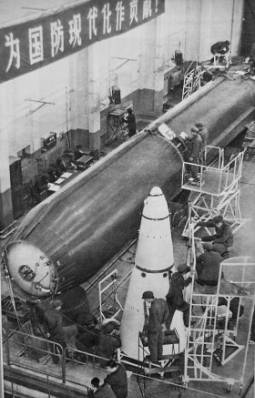The Chinese DF-3 missile |
||||||||||||||||||||||||||||||||||||||||||||||||||||||||||
|
"The Dongfeng 3 (DF-3) medium-range missile is completely
independent of China's self-developed liquid-ground medium-range missiles:
Missile full length about 22.47m, maximum diameter of 2.25m, a takeoff weight
of 65 t, the propellant can be stored as unsymmetrical dimethyl hydrazine
/ nitric acid, engine ground thrust 104 tonnes (four single parallel connection),
the control system for the location SINS guidance, warhead is a 3 million
tons TNT equivalent of thermonuclear warheads". |
||||||||||||||||||||||||||||||||||||||||||||||||||||||||||
Early firings of the DF-3 were from Shuang Chengtzu during 1966 and then moved to Wuchai for longer-range testing in 1968.
There are at least two
versions of the DF-3. The initial model had a range of about 2,650 kilometers
and carried a single nuclear warhead weighing 2,150 kilograms. During 1983
and 1984 a range extension program on the DF-3 increased the range of the
DF-3A to 2,780 km. Of a total of some 100 DF-3 missiles, about 80 are
of the improved DF-3A version which was deployed beginning in 1988.
The DF-3 provided the
first stage for the follow-on two-stage DF-4 missile. It also provided the
first stage of China's first space launch vehicle CZ-1. |
|
|||||||||||||||||||||||||||||||||||||||||||||||||||||||||
|
|
||||||||||||||||||||||||||||||||||||||||||||||||||||||||||
|
|
||||||||||||||||||||||||||||||||||||||||||||||||||||||||||
|
|
|
|||||||||||||||||||||||||||||||||||||||||||||||||||||||||
|
|
||||||||||||||||||||||||||||||||||||||||||||||||||||||||||
|
|
|
|||||||||||||||||||||||||||||||||||||||||||||||||||||||||
|
|
||||||||||||||||||||||||||||||||||||||||||||||||||||||||||
|
Dongfeng-3 missile nuclear weapons development history Source: http://liuqiankktt.blog.163.com/blog/static/1212642112009112743717541/ The "Dongfeng 1" (later renamed to DF-3) exploration and evaluation work program beginning in 1958. Gradually began to discuss the various options. The first consideration is what kind of propellant. Some advocate the use of liquid oxygen and kerosene, and some advocate the use of red fuming nitric acid and kerosene, as well as recommendations with red fuming nitric acid and UDMH. After analysis and discussion, consider using kerosene as fuel is difficult to solve the problem of high frequency combustion instability engines; while toxic hydrazine as fuel and too much. The third design to collect data from the Ministry, discusses ways to new engine technology, and the design and research in conjunction with relevant departments of kerosene, and mixed amines such as hydrazine fuel to do thorough research and comparison. Also in the study of the overall program, also encountered the projectile diameter in the end how much is a good question. Some advocates continue to follow the DF-2 (similar Soviet R-5) in diameter. Some advocate the use of 2.5 m in diameter. Advantages and disadvantages, in-depth research and analysis to be done. Control system is also proposed various options envisaged. In June 1960, the first in the overall design of the study, based on a preliminary analysis, each subsystem "Dongfeng 1" proposed design of technical requirements. Engine (codenamed "5D10") single thrust of 20 tons, four machines in parallel. Propellant mixture of nitric acid and amine. Addition: The DF-1 idea originated from Soviet missile R-12. Similar to the R-12, the DF-1 used storable liquid propellants (TG-02/AK-20) for improved readiness and had a cluster of four engines with a total lift-off thrust of 64 tonnes. This idea was not followed. Originally, the DF-1 was planned for completion before the DF-2. In 1964, the Central Military Commission redefined the different and since 1960 developed DF-1 program and gave the new designation DF-3. The DF-3 have four engines in a cluster providing 96-tonne lift-off thrust and using UDMH/AK-27 propellants. In August 1964, the Fifth Academy scheduled the DF-3 flight tests to start. The propulsion. The 5D10 engine developed individual progress. After April 1960, to determine the use of red fuming nitric acid and mixed amine as 5D10 engine propellant, began the research and design work. By the end of 1962 to the first half of 1963 have built a hydraulic liquid rocket engine test chamber, the test chamber and the turbopump medium heat test chamber, the gas generator to solve a series of low-frequency combustion instability technical problems and create the necessary conditions, but also for the whole engine system test and create the conditions. November 1964 built a test bed. To find out instead of using the mixed amine UDMH problems brought decided to use 5D10 engine tests. March 1965, conducted the first trial heat, combustion instability problem occurred shortly after the start.This is the first hurdle after the official launch of the development of medium-range missile engine encountered. Using five different "liquid partition" the head of the program, tests were unsuccessful. This suggests that "liquid partition" scheme to suppress high frequency oscillation little effect UDMH and nitric acid produced by combustion must find another way. From March 1965 to start within 11 months, a variety of programs designed for 30, 80 carried out several tests, including the failure of successive 17 times. Structural design and theory work closely with researchers, weaknesses, to workshops, laboratories with the technology staff, and workers together to test repeated discussions, testing, brainstorming, proposed a "liquid partition" and "bulkhead partition" of the new combination regimen, After a hot commissioning assessment, indicating that this program is effective, so far, the high-frequency combustion instability of major breakthroughs in key technologies eventually, for the rapid development of a liquid engine technology opens the way. With this program engine codenamed "YF-1", that is, single engine missiles. July 1965, has been short-and long-range four-parallel test, the engine according to a predetermined program starts, the main stage work, transfer of class and off, not only to coordinate the work of the four extensions, and stable performance, indicating feasible. Engine thrust chamber head injection system is composed of over 2000 stainless steel nozzle components. Small nozzle size, precision, finish, shape and position tolerances and flow test accuracy requirements are high. The airframe. After repeated tests to determine the projectile diameter of 2.25 m; propellant tank with a ribbed reinforced mesh structure of high-strength weldable aluminum alloy corrosion resistance and chemical milling, so that the weight of the tank to reduce medium-range missiles of 25% - 30%; sensitive alloys with medium-range missiles on the cylinder, thereby significantly reducing the weight of the structure. A missile with a titanium alloy cylinders instead of cylinders, we can reduce the structural weight of over 100 kg; separation mechanism and missile warheads for the first time with a shear bolt and gunpowder explosion actuators, simple and reliable structure , the operation is very convenient, greatly reducing the head, body docking connection time.
1963, August. The "DF-1" parallel with four liquid rocket
engine as the power plant; propellant using UDMH and nitric acid; control
system actuators fight with swing engines, such as the development does not
come out swinging engine one o'clock, to use gas as a transitional rudder;
the control system uses dual compensation programs; to increase the reliability
of the control system, consider using duplicate circuit; be pressurized with
nitrogen after heating; structure of the basic material is aluminum; warhead
basic materials using heat-resistant glass, steel, end the use of laminated
steel or reinforced glass ceramics; projectile diameter of 2.25 m is recommended.
DF-3A |
||||||||||||||||||||||||||||||||||||||||||||||||||||||||||



